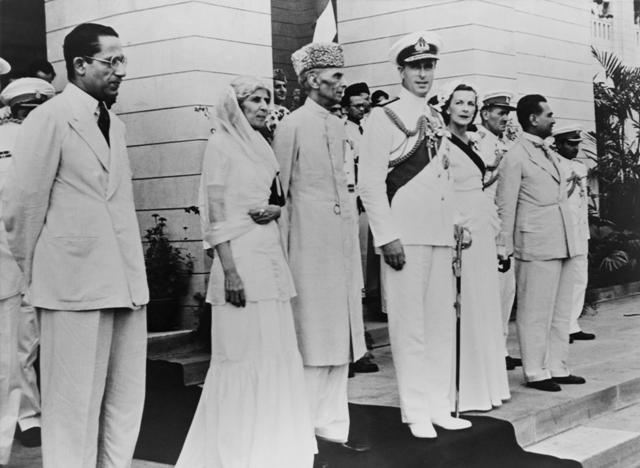 Lord Louis Mountbatten handing over power to Mahomed Ali Jinnah on Aug. 14, 1947. On the next day Jinnah was sworn in as Pakistan’s first governor-general and President of Pakistan's constituent assembly. [photo source: Alamy]
Lord Louis Mountbatten handing over power to Mahomed Ali Jinnah on Aug. 14, 1947. On the next day Jinnah was sworn in as Pakistan’s first governor-general and President of Pakistan's constituent assembly. [photo source: Alamy]
[This is an excerpt from an article in The Round Table: The Commonwealth Journal of International Affairs.]
Pakistan gained independence from British rule in 1947 and made a promising start in terms of reorienting its economy and society towards achieving industrialisation. In the 1950s and 1960s, Pakistan’s industrial productivity grew and the country came to be seen as a potential breakthrough story. That period in Pakistan’s history is still reflected upon with nostalgia by many in the ruling elite and some associated with that period have continued to advise governments to the present day. Unfortunately for those emotionally invested in romantic notions of a Pakistan that was on the path of material progress, the gains in industrial concentration and output were achieved alongside high levels of defence spending through dual subsidisation. One aspect of this subsidisation was that West Pakistan did the modernising while East Pakistan paid the bills, and the other aspect was that the United States and its allies gave or lent Pakistan money, provided advice, political clout, and armed it (to fight communism). Whether access to such subsidisation could have been sustained for longer is open to question, but it is clear that the ruling circles in West Pakistan, which dominated decision-making since April 1953, had political and strategic goals that complicated matters.
Politically, there was a broad unwillingness to share power with East Pakistani leaders on fair terms that would concede the representative leadership in exchange for the economic subsidisation of West Pakistan. Different formulas and constitutional experiments by a governing corporation of largely West Pakistani civil servants and military officers alienated East Pakistan and pushed its leaders and people towards separatism. While East Pakistanis were being made to pay for development in West Pakistan, the Pakistani government was interested in pursuing major foreign policy objectives against India. This contributed to the 1965 India–Pakistan war and marked the beginning of Pakistan’s alienation from the United States, which was also facing its own problems on account of the Vietnam War. Between the alienation of East Pakistan and the alienation of the United States, Pakistan’s leaders set the stage for evaporation of both sources of subsidisation. By 1972, Pakistan had lost both its eastern wing and the active military and economic support of the United States.
The challenges faced by the Pakistan government in 1972 were enormous. The goal remained to achieve industrialisation but the method switched dramatically to confiscatory nationalisation accompanied by purges and politicisation of the state machinery. The effect was that the country’s industrial development was derailed, the gap between revenues and expenditures went above 10% of GDP, and the external balance (which had been positive due to East Pakistan’s exports) turned negative. By the time the military intervened in 1977, Pakistan had ceased to be a developing country and the relative distance between it and other countries in its peer group started to grow to Pakistan’s disadvantage. Indeed, countries that were significantly worse off than Pakistan started overtaking it after 1980.
Pakistan’s return to military rule did not bring about a shift in favour of modernisation. Instead, while pandering to the emerging free-market fundamentalism abroad, the Zia regime aggressively promoted religious fundamentalism within Pakistan in order to gain legitimacy. This dovetailed neatly into the broader US-Soviet struggle on account of the latter’s invasion of Afghanistan in December 1979. By 1981, western military and economic assistance was set to resume and, with it, internal proposals for meaningful reform lost regime support. That Pakistan’s economy grew by a healthy rate of 6% a year between 1981 and 1988 temporarily masked deep structural failures of administration, provision of services, and planning. As soon as the Soviets were out of Afghanistan, the US ended its entente, put Pakistan back under sanctions, and refused to play any constructive role in coping with the fallout of that conflict. Pakistan, for its part, was locked into a predictable cycle of structural adjustment in which foreign exchange strapped governments went to the IMF for bailouts and received financial support in exchange for coercive liberalisation of the economy.
Each round of liberalisation left underlying problems unaddressed while making Pakistan more vulnerable to external shocks and competition. Exports stagnated, investment tanked, poverty and hunger grew, inequality rose, tax collection went nowhere in proportionate terms, and the country effectively de-industrialised. All these factors made productive spending more difficult owing to intractable defence and debt burdens.
Ilhan Niaz is with the History Department, Quaid-e-Azam University, Islamabad, Pakistan.



